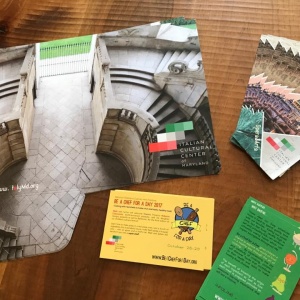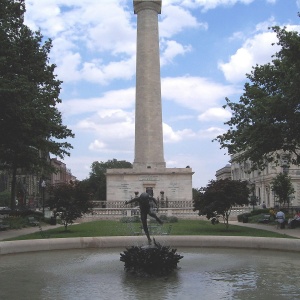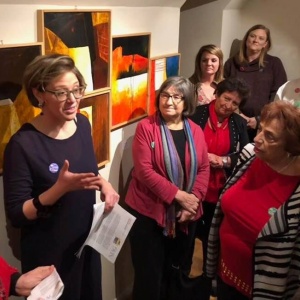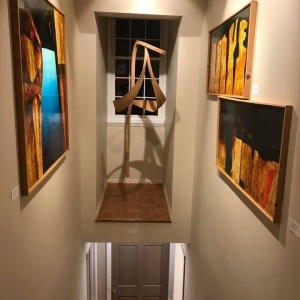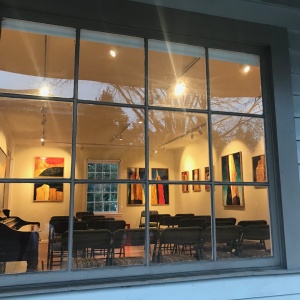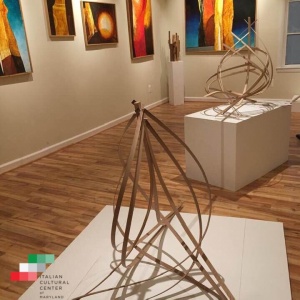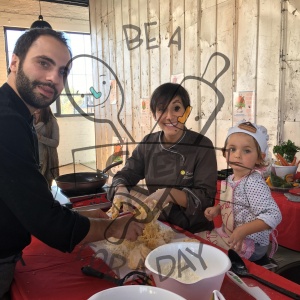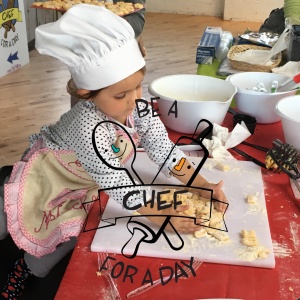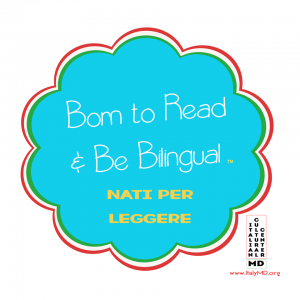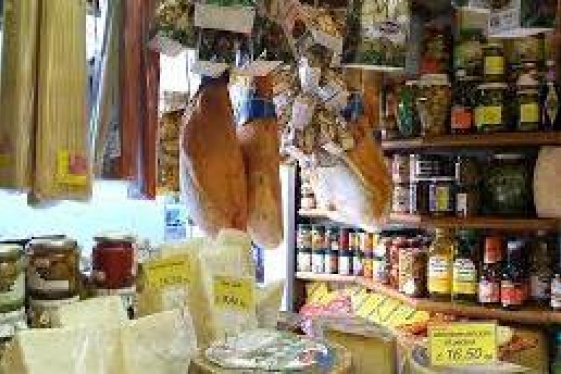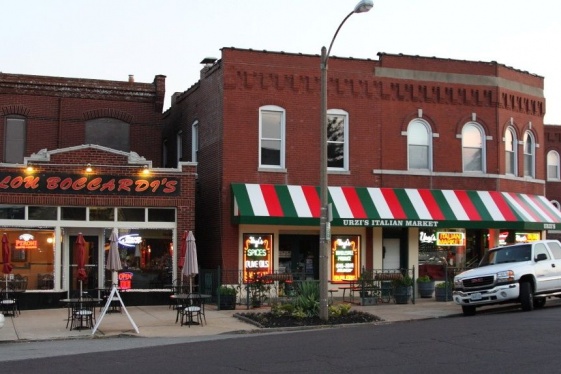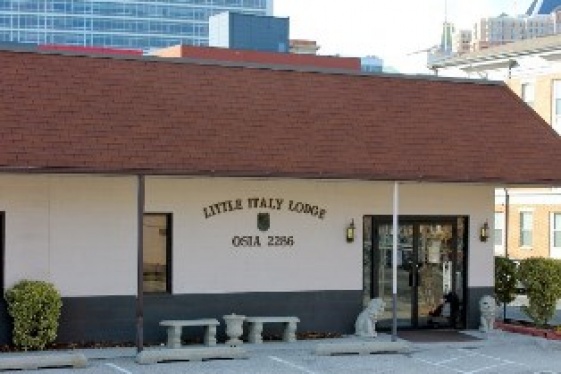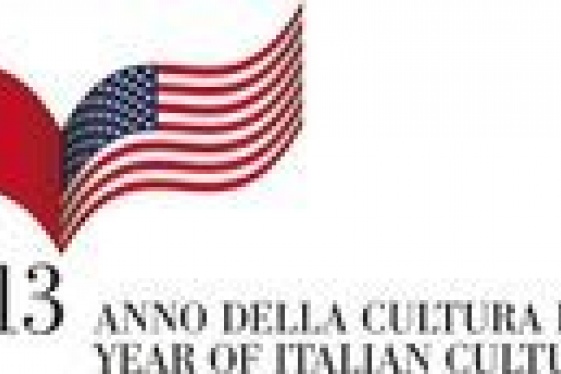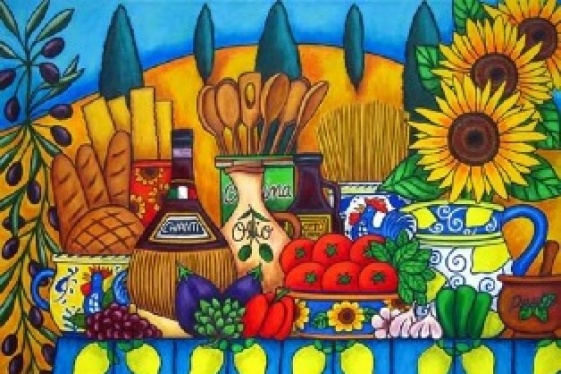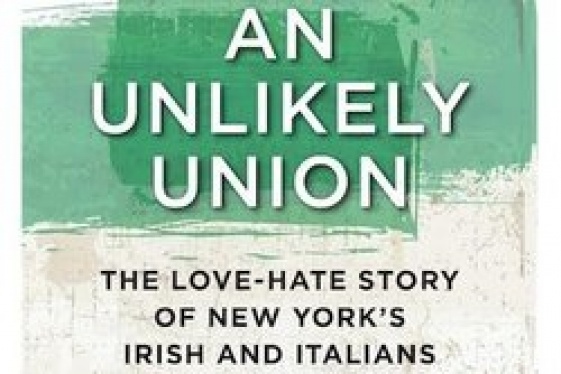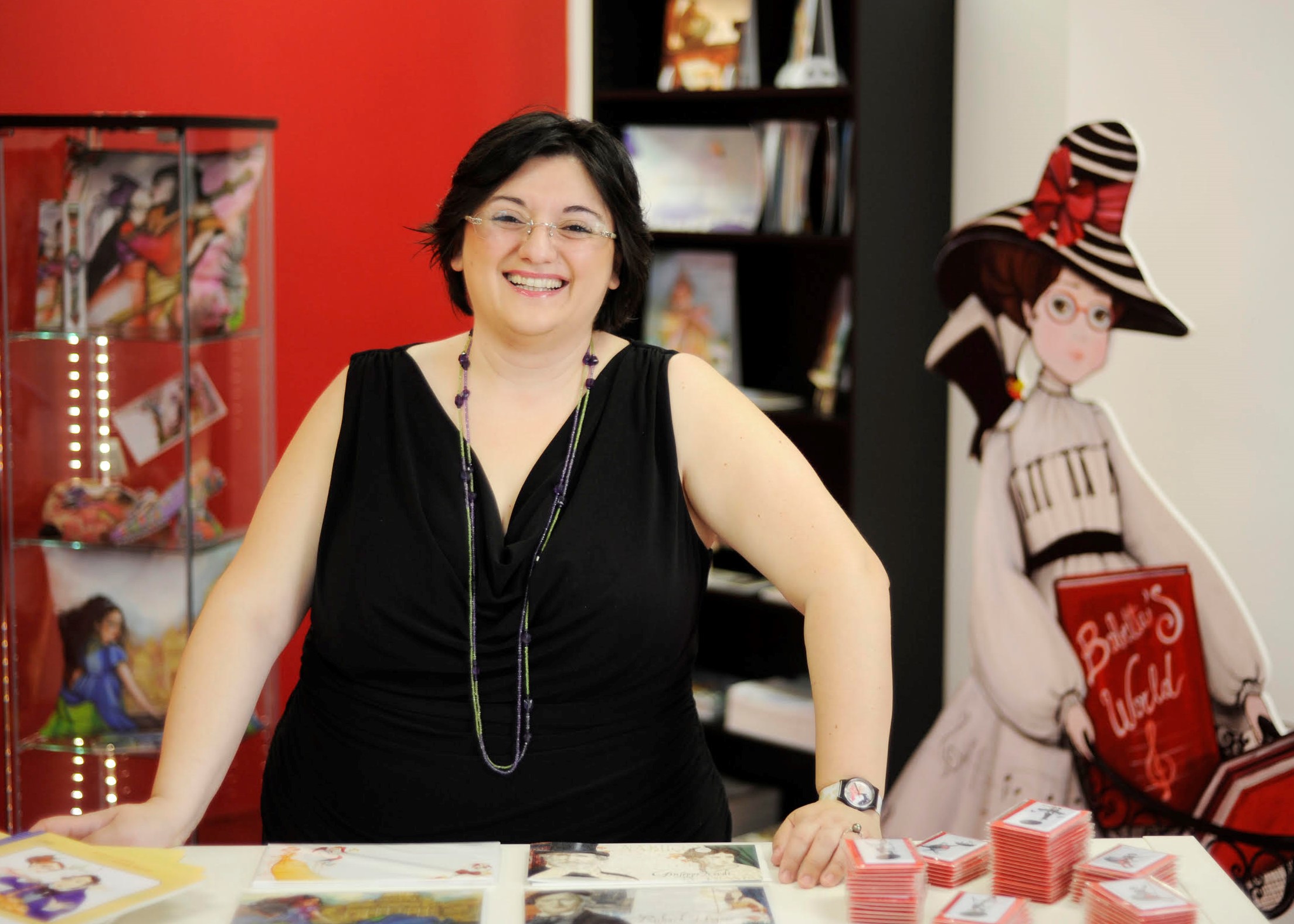
Monica Lapenta (President of the Italian Cultural Center of Maryland)
Istruzione, Arte, Cultura, Cibo, Multimedia, Storia: passato, presente e futuro dell'Italian Cultural Center of Maryland

Many extremely interesting things are happening and will happen in the community that in Baltimore celebrates Italy and its cultural and artistic heritage. These activities, which have been running alongside others for some time, are carried out by the Italian Cultural Center of Maryland, thanks to a capable and committed staff led by an Italian woman who has recently emigrated to the Old Line State.
We are therefore very happy to welcome to We the Italians our dear friend Monica Lapenta, President of the Italian Cultural Center of Maryland in Baltimore.
Monica, you are the president of the Italian Cultural Center of Maryland. You've been in the United States for less than ten years, it's not common to find an Italian woman who's only recently arrived in America to lead such an important club in a city as full of Italian Americans as Baltimore. How did you get to America?
I arrived definitively in 2011, because in 2009 I opened a children's book distribution company with an American partner. I traveled between Italy and the United States for two years, and then because it was complicated to do three weeks in Italy and three weeks in the United States as a single mother of a child who was then three and a half years old, I had to make a decision and chose to move: I would try my American dream. There was a good, very good dose of unconsciousness, because when I think about it I find it hard to understand how I did it, but all in all I wouldn't change anything.
It was a remarkable learning curve, also because what you see in the United States when you spend time there sporadically, is totally different from what it really is once you live here and you are an integral part of it.
I moved first of all because I was angry with the "Italian system", which, in my opinion, did not give young people like me the opportunity to do what they wanted. I had an official career with a serious job in a bank, I had great professional satisfaction with the new publishing house, but on the economic side it was very complicated. When I arrived in the United States, on the other hand, I found a streamlined procedure, ease of contact and an understanding that the work had to be paid for. The thing that shocked me at first, not even surprised, was that you were paid with a check by mail: how was it possible that in Italy we could not do something so simple? Then, more than a publisher, I am and feel like a writer: objectively, the United States is the country that, despite the great differences and great political alternations, gives more than anyone the chance to succeed if you work hard, unlike Italy, unfortunately.
What do you miss most about Italy?
Not much. I am from Campania but I spent the majority on my life in Turin first and Milan lately, and sometimes I miss the opportunity to walk with my son through the streets of Milan where he was born or to take a plane and make a detour to see "my" sea for a weekend.
It's strange: I lived in Italy for 35 years before moving, but we're still not at the point where I miss it, probably because I live here in a very big city that has the same cultural stimuli as a big city like Milan. I always say that Milan and Baltimore are similar, if it were not for the sea they would be identical: there is the same way of understanding work and culture. Baltimore is an incredibly lively city from a cultural and artistic point of view.
Tell us about the history and mission of the Italian Cultural Center of Maryland
The center was founded under the name of Circolo Culturale Italiano in 1955 by Regina Levi Bianchini Soria, a Neapolitan professor who came to teach Italian literature at Notre Dame University here in Baltimore. At the time she felt the need to bring together the Italian community, rather than the Italian American community, who lived in Baltimore, to keep alive the cultural wealth that these emigrants lacked, especially to keep the language alive.
After the Second World War, Baltimore was the destination of many doctors and scientists, who were recruited by the U.S. Department of State and were offered the opportunity to move to the United States because they lacked, locally, Americans with those skills. Baltimore was a city rich in Italian culture, with wonderful dinners and seminars held once a month.
Over the years, Italian emigration to Baltimore also changed its face. There were more and more Italian Americans than Italians and cultural assimilation had diluted the culture of the mother country, which in some cases was already little at the beginning, because most of those who emigrated were not educated.
The American educational system did not know much about bilingualism and, in some ways, does not yet know much about it. It required that children abandon Italian completely and, partly out of ignorance and partly out of necessity, the language, with a few exceptions, was lost.
Stereotypes were built and fed on about the average Italian, spaghetti and meatballs (which all Italians know is not an Italian food but has a precise explanation linked to the hardships of immigration) and about the belonging of Italians, especially from the south, to the mafia.
In the 70's "Il Padrino I e II" (The Godfather I and II) was released and these two very successful films only increased the spread of these stereotypes and Professor Soria decided to fight the wrong image of the judgment that was given on Italy.
In 1979 she created a conference called "The Marble Door" dedicated to the cultural contribution of Italian artists such as Enrico Causici and Antonio Cappellano, two great sculptors who emigrated to the city in the 19th century. In fact, they carved everything beautiful in Baltimore, including "Lady Baltimore", the symbol of the city, and the Washington Monument. Together with Costantino Brumidi and many other sculptors, writers, artists, doctors and craftsmen who represented the best of what we had exported to America: ingenuity, inventiveness, hard work, love of the homeland, gratitude for the opportunity given, the strong sense of family.
That was the intent of the Marble Door and from then on the association has continued to promote the work done by the Italians.
Finally, in 1999 the then Italian Honorary Consul General in Baltimore, Francesco Legaluppi, founded Italcultura, the non-profit foundation that aimed to collect the legacy of the Italian Cultural Circle.
Professor Soria wanted to give a legal form to what was an unstructured association of Italianophiles and had found in Francesco Legaluppi, active in the club since he was a child through his parents Marcello (historical Italian Consul in Baltimore) and Luciana, the right person to leave the leadership of the association. For this reason Italcultura joined with the Circolo Culturale Italiano, and the Italian Cultural Center of Maryland was born, a non-profit foundation.
Our slogan is "Put a bit of Italy in everyone's heart". Authentic Italy, which may be missing for me, which you miss after you have lived it, the Italy that our ancestors have left and that, in many, have never seen again. Italy, a thousand-year-old cradle of culture that produces talents and beauty that need to be brought to fruition even of second and third generation Italians. Not the Italy of the stereotype that does not exist and is only a source of lack of knowledge.
There are many Italian souls in Baltimore but we can divide them for convenience in two: the first is composed of a recent immigration of people who are proudly Italian and who want to maintain their language, their culture, their customs, transmit the love for art and literature: this immigration has similarities with that of the late '800. On this we will do in April 2019 an exhibition entitled Una casa italiana a Baltimore agli inizi del ‘900.
The second soul is that of the children and grandchildren of immigrants or descendants of the second, third or sometimes fourth generation (considered Americans of Italian Heritage), with an Italian surname or an Italian grandfather. They have never or almost never had the direct experience of what Italy and its culture are, but they have a memory that has been handed down to them by their ancestors who have come here eager to build a bright future and have worked hard to achieve that purpose, and who have an idea of Italy very different from what Italy really is today or has been in the last 100 years.
At the beginning of November you have opened the National Italian American Gallery. What is it about?
The purpose of the National Italian American Gallery is to celebrate the contribution that Italian artists and their descendants have made to American cultural life and to introduce contemporary Italian artists to the American public. It is very important for us, as a cultural center, to continue to promote the beating heart of our history: art as a universal language, as a starting point to create contact. We deeply believe that through art and its forms, such as music, for example, many difficulties can be overcome and that the true reality of Italy can be known.
Guided tours for adults and children are available every day. In the coming months will start a wonderful art program for children who have difficulties of attention and who have had traumas.
What are the main activities of the Italian Cultural Center of Maryland?
The Italian Cultural Center has two distinct souls: the historical one, that is art, culture and promotion of the authentic Italian cultural heritage; and the more contemporary one, of service to the community in general, that we define as "community at large". This second soul is due to my work, because when I arrived at the Italian Cultural Center in 2012 there was a period of transition, in which we had to decide how to make a difference in a rapidly evolving society.
So we created the "Be a Chef for a Day, National Children's Culinary Arts Festival": a two-day festival (next year's festival will be held on March 3 and 4, 2019), in which we celebrate the Italian culinary tradition helped by Matt and Sphen (a wooden spoon - Sphen - and a rolling pin - Matt - two characters created by me).
I didn't expect the answer I got from Italian chefs, teachers and educators and especially from parents and children: the festival was a huge success!
After the festival they asked me to create a second program for an association that assists children in need, which at the time was called "Big Brothers Big Sisters of the Greater Chesapeake" and today is called "Big Brothers Big Sisters at the Y". The kids assisted by this foundation are children with difficulties who are supported by a mentor, a person who makes him/herself available and lends his/her expertise to offer the child an extra help. I have to admit that being myself, in 2015, still a young emigrant, I was not completely aware of what American life was all about: that was a "crash course". So Be a Chef for a Day Big Little was born.
Getting in touch with children, the most vulnerable in society, and realizing that there was this huge problem of access to food, marked me deeply.
How could I create a good program if I didn't know the problem directly? The memories of me as a child came to my aid. I wasn’t used to playing with the other children, but I was used to listening to the old people talking! Grandma Mena, my dad's grandmother, recounted with great modesty mixed with pride and irony the difficulties she had had when it came to making ends meet.
How do you cook every day without going bankrupt? How do you put food on the table seven days a week?
All Italians (even the rich who have remained so) have historically had to face this daily post-war dilemma and so, taking advantage of our traditions, we created Be a Chef for a Day - Mr. Brown the Grocery Bag (where the brown bag is an animated character called Mr. Brown): a culinary education program for children that works wonderfully!
We received incredible help from Marcato, an Italian company that makes machines for fresh pasta, which has been one of the sponsors of the festival and the program from day one, and which delivered to us machines for pasta the day before the festival in 2015. It's a combination that has worked wonderfully for four years and I'll never stop thanking them for it.
By calibrating the program from year to year, we have discovered a great passion and involvement of children. We have replicated it in several different schools of Baltimore and we have seen how the program gives concrete help to children. That is because it not only teaches them to cook with the classic Italian Mediterranean diet, but also to cook using what they have at home, keeping a budget in line with what they can easily find when they do their shopping, without having to spend too much money. We pay attention not only to food but also, for example, to the utensils we have in the kitchen: not everyone has the tools of a super chef, but everyone has a wooden spoon and a bowl, we learn from that.
It was and is an incredible experience for me and for all of us at the Italian Cultural Center. The annual festival has now expanded and together with our Italian culinary tradition we also promote art in all its forms and linked to food.
In addition, on October 27th of this year we started a new cultural program in collaboration with the public library system: the Italian Festival at Enoch Pratt, Baltimore's historic public library. This event is the most tangible example of Italian culture accessible to all and expands our weekly collaboration with the system of public libraries that was born with "Nati per Leggere - Born to read and Be Bilingual", a program of reading in Italian to American children from 0 to 6 years, every Thursday.
Besides the classes of Italian culture and language, which are very important, we also have a program called "Mini Italia", designed for children, with a section dedicated to Home School, so you can use Mini Italia from home to learn about the Italian language and culture, through art and much more.
The National Italian American Gallery will increasingly represent one of the focal points of our dissemination activities through its programs for children. The exhibition with which it has been inaugurated, Two: Genres in comparison. Bambagini e Celi, drew attention to the contrast between a veteran of painting such as Mario Bambagini, a painter who was born in Grosseto and has been in Rome for a long time, a multifaceted artist and absolute master of colour; and a young Italian American wood sculptor, Martina Celi. The result was an authentic success curated by Gioia Milano, our Director of Education and Exhibit.
There are other activities that will arise in the future: for example, we have inherited from the John Hopkins' Department of Astronomy an exhibition called The Astromobile that is now in Columbia, MD, in a center called Robinson Nature Center. It's a scientific exhibition realized by an Italian astrophysicist, Luciana Bianchi, which was donated to the center so that we can later add the story of Galileo Galilei.
The Caffè Letterario that we organize for our members and their guests every first Sunday of the month, from June to October, is a conversation with local personalities on substantially topical issues and their history of immigration.
In May 2019 we will redo "The Marble Door", to celebrate the 40th anniversary of that conference, repeating it and taking stock of the situation on the state of promotion of the Italian contribution to American cultural life: have we become better at promoting ourselves? We would be happy if We The Italians would like to help us in this regard.
We will be happy to help! I know that you are also working for the spring of 2019 on the opening of the National Italian American Film Institute and on an exhibition in a newborn museum on Italian emigration to the United States ...
The exhibition will be called Una casa italiana a Baltimore agli inizi del ‘900 (An Italian house in Baltimore at the beginning of the 20th century). The exhibition is the result of a donation received by the Italian Cultural Center in 2017 from an extraordinary woman, Donna Pernicano, on behalf of the families Vivirito, Fontanazza, Papania and Bove. Mrs. Pernicano, the only heir, has donated to our museum all that her family has jealously guarded over the years since 1901.
When our idea, for reasons of space, changed from the initial one - from a permanent exhibition on emigration to a temporary exhibition - she assisted us, listened and supported us in an incredible way. It was enlightening for me to see how an American woman, very American, feels her Italian origins so strong that she says: "I want the Italian tradition of my family to stay alive, so please put the title in Italian". The exhibition will open at the end of April 2019 and will recreate their home, the home of their great-grandparents, identical to how it was. We have all their photographs, like that of her grandmother's wedding in 1911, sitting at the same table that we will use with the same furniture they had and, on the table, the same wedding gifts.
What we hope in the future is to be able to move to a larger location, to have that permanent exhibition as well. The family, however, was clear: they don’t want what can be considered a repository. Mrs. Pernicano told me: "I don't want to go in and think that this is the celebration of my family, otherwise I would have kept these memorabilia in the house. The reason why we decided to donate this to the museum is so that you can use these relics to tell, through them, the story of Italian immigration.
The objects of the exhibition are an instrument, not a self-celebration of the individual immigrant, and this is the spirit of our Gallery. We are interested in telling stories: why did you emigrate? What was the problem? What did you miss in Italy? What were your difficulties? We want to include the individual stories in a single process that also allows to amplify the cohesion between us Italians, still little present today.
There are many clubs but there is no collaboration. And the lack of collaboration means that we don't get the results we deserve. A striking example is the failure to celebrate Costantino Brumidi, who was given a ceremony in haste, while he should have had a full year of celebrations.
At the beginning of the landings the Italians were cohesive, they spoke Italian, there were periodicals in Italian published in the United States, there were Italian banks, Italian companies... we lost a piece of that, and it is our duty to find it again.
As for the National Italian American Film Institute, the idea comes from the fact that there are new Italian American filmmakers in the United States, young and ambitious, who are incredibly linked to their Italian culture and history of emigration, who always create new films, inspired by Italy.
Until now, there was no institution in charge of safeguarding this heritage. Why is it so damn complicated to show, for educational purposes and especially for cultural dissemination, an Italian film? Why should it always be difficult, when it is known that one of the main forms for the promotion of culture is the diffusion of the language? What better way if not cinema? Why don't we promote new films, new short films? I'm pushing hard to create an Italian American Short Movies Festival here in Baltimore.
We want the National Italian American Film Institute to be an institution that brings together different partners in Italy and America with a single aim: to promote Italian and Italian American cinema, sponsoring old and new projects in a cohesive way. This is something that America has taught me: you are much more successful if you go along with others than if you go alone. We already have some collaborations with other non-profit organizations in Baltimore, and the reason why we are very successful is that we move together in one direction: that's what we Italians in America lack. We need to put aside our ego and our individual interest, to look at the "big picture": the big picture that we have given ourselves for the Institute is that we Italians want to be recognized.
All these great Italian American names, who have done so much, to whom the millions of Italian Americans are so attached... the time has come to put everyone around a table and promote the multimedia contents that have celebrated and are celebrating Italy thanks to the Italians and the Italian Americans.
Who are the new Italians, recently arrived in America like you, who live in Baltimore today?
There are several new, extraordinary Italians: scientists, astronomers, doctors, biologists, italianists, engineers, chefs. There is an incredible cultural ferment in Baltimore.
Let's take for example Mario Scarpa, president of the "Club Italiani a Baltimore": he is from Campania like me, and with me shares the importance of proceeding together towards a common goal. Mario is a researcher who works at the University of Maryland, in the oncology field. Having for the first time in a long time a group of Italians, recently immigrated, who are interested in making a difference in the city and state where we live, is especially important in a city like Baltimore, where today there is no Italian institutional presence, since the closure of the Honorary Consulate General.
What are your goals for the most distant future?
For the 75th anniversary of the Foundation (2030) a new large structure that can accommodate the Gallery, our culinary programs, our language and culture classes and, why not, the first public school in America completely bilingual; and an Italian Theatre.
You may be interested
-
‘Fuggedaboudit’ the motto of new Italian del...
By Kimberly Sutton Love is what brought Tony Nicoletta to Texas from New York.The transpl...
-
“The Hill” St. Louis’ Little Italy
When the fire hydrants begin to look like Italian flags with green, red and white stripes,...
-
1st Annual Little Italy Cannoli Tournament
Little Italy San Jose will be hosting a single elimination Cannoli tournament to coincide...
-
2015 scholarship competition
The La Famiglia Scholarship committee is pleased to announce the financial aid competition...
-
A Week in Emilia Romagna: An Italian Atmosp...
The Wine Consortium of Romagna, together with Consulate General of Italy in Boston, the Ho...
-
An Italian American Feast For Family Reunion...
Hey, come over here, kid, learn something. ... You see, you start out with a little bit of...
-
An Unlikely Union: The love-hate story of Ne...
Award-winning author and Brooklynite Paul Moses is back with a historic yet dazzling sto...
-
Buon Appetito! Unique Italian dining at Ragú...
There's something to be said for having your food prepared tableside. Guacamole tastes fre...






